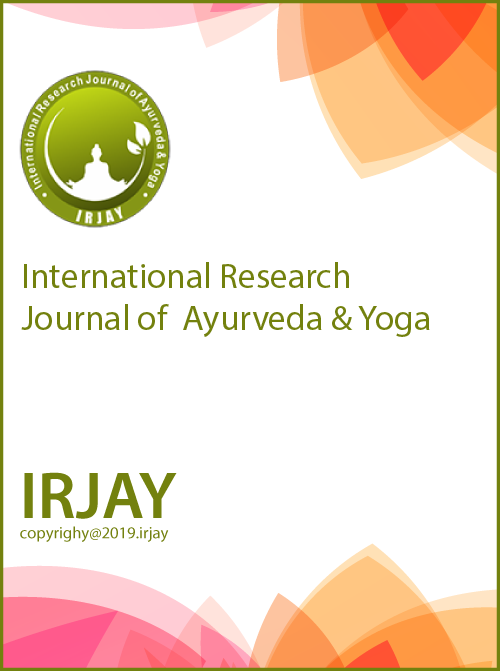Vyadhibala and its Assessment – A Narrative Review
Keywords:
Dehabala, Panchanidan, Pareeksha, RogabalaAbstract
Ayurveda is a comprehensive medical system based on ancient medicine. To become an expert and achieve dominance in clinical approaches, one must possess a thorough comprehension of science. In clinical medicine, the first stage is a thorough evaluation of the patient, which is followed by the planning of appropriate therapies. If a doctor starts treating patients without properly diagnosing the condition, achieves the desired result by accident, and does not become well-known. Conversely, a doctor will undoubtedly succeed if he gives medications following a correct diagnosis and develops the primary course of care after taking the morbidity of pathogenetic variables, strength, location, season, etc., into account. Charak described Roga Pariksha and Rogi Pariksha for the diagnosis and prognosis of a disease. Rogabala can be assessed by Nidana Panchakas, i.e., Nidana (etiology), Purvarupa (premonitory signs and symptoms), Rupa (signs and symptoms), Upashaya (explorative theories), Samprapti (pathogenesis) along with the knowledge of Sadhyasadhyata, Ama-Nirama Avastha, Upadrava (complications), Arista (bad prognostic indicators), and the efficiency of Chikitsa Chatushpada. Assessing Rogabala is essential for proper diagnosis, treatment, prognosis, and academic research in Ayurveda. It determines severity, predicts disease progression, and guides treatment intensity. A well-researched study on Rogabala can bridge traditional knowledge with modern clinical applications, improving the effectiveness of Ayurvedic treatments. Ayurveda, the science of life, maintains the health of a healthy individual and cures the disease of a patient. At present, people are suffering from different kinds of diseases, which are idiopathic, immunosuppressive, and diseases of different origins. As per Astanga Hridaya, the term Roga refers to the imbalance in the proportions of Doshas.[1] The word Roga refers to any kind of pain or discomfort that will be observed in diseased people. Roga is derived from Ruk or Ruja. Assessment of the strength of a Roga is very important for a clinician for the diagnosis, prevention, and treatment. Before giving any kind of treatment, one has to identify the actual illness the individual is suffering from, and then only the physician has to give appropriate medications. Rogabalas here stands for the strength of Roga, the Avastha, or stages of Roga, whether it will be cured or become chronic with the production of disabilities in a patient or may cause death of the patient. The following factors have to be employed during the proper diagnosis of the disease.
Downloads
References
1. Gupta A, editor. Ashtanga hridaya: Sutrasthana, doshadivigyaniyadhyaya 11/4 (vidyotini commentary). Varanasi: Chaukhambha Prakashan; 2019.
2. Kashinath P, Chaturvedi G, editors. Charaka samhita: Nidan sthana, jwara nidanam 1/8 (vidyotini Hindi commentary). Varanasi: Chaukhambha Bharati Academy; 2019.
3. Yadunandan U, editor. Madhav nidan; Madhukosh vyakhya panchanidan lakshanam 1/4. Varanasi: Chaukhambha Bharati Academy; 2019. 4. Kashinath P, Chaturvedi G, editors. Charaka samhita: Nidana
sthana, jwara nidanam 1/8 (vidyotini Hindi commentary). Varanasi: Chaukhambha Bharati Academy; 2019.
5. Kashinath P, Chaturvedi G, editors. Charaka samhita: Nidan sthana apasmara nidanam 8/27-29 (vidyotini Hindi commentary). Varanasi:
Padhi and Mohanta: Vyadhibala and its Assessment 2025; 8(5):45-50 49
Chaukhambha Bharati Academy; 2019.
6. Gupta A, editor. Ashtanga hridaya: Nidan sthana, sarbaroga nidanadhyaya 1/7 (vidyotini commentary). Varanasi: Chaukhambha Prakashan; 2019.
7. Kashinath P, Chaturvedi G, editors. Charaka samhita: Nidana sthana, prameha nidanam 4/4 (vidyotini Hindi commentary). Varanasi: Chaukhambha Bharati Academy; 2019.
8. Shastri A, editor. Sushruta Samhita: Chikitsa sthana anagatabadha pratisedha 24/10 (ayurvedatatva sandipika commentary). Varanasi: Chaukhambha Sanskrit Sansthan; 2019.
9. Kashinath P, Chaturvedi G, editors. Charaka samhita: Sutra sthana khuddaka chatuspada adhyayam 10/9 (vidyotini Hindi commentary). Varanasi: Chaukhambha Bharati Academy; 2019.
10. Kashinath P, Chaturvedi G, editors. Charaka samhita: Chikitsa sthana, visarpa chikitsitam 21/40 (vidyotini Hindi commentary). Varanasi: Chaukhambha Bharati Academy; 2019.
11. Yadunandan U, editor. Madhav nidan; Madhukosh vyakhya Panchanidan lakshanam 1/2-3. Varanasi: Chaukhambha Bharati Academy; 2019.
12. Sharma RK, Dash B, editors. Charaka samhita of agnivesha, sutra sthana. (naveganadharaniya adhyaya). Ch. 7., Ver. 3-4. Varanasi: Chaukhambha Sanskrit Series Office; 2014. p. 140.
13. Sharma RK, Dash B, editors. Charaka samhita of agnivesha, vimana
sthana. (vikruti vijnaniya vimana). Ver. 9-10., Ch. 5. Varanasi: Chaukhambha Sanskrit Series Office; 2014. p. 274.
14. Sharma RK, Dash B, editors. Charaka samhita of agnivesha, chikitsa sthana, (atisara chikitsa). Ver. 44-5. Varanasi: Chaukhambha Sanskrit Series Office; 2014. p. 458.
15. Kashinath P, Chaturvedi G, editors. Charaka samhita: Chikitsa sthana vatashonitam, chikitsitam (vidyotini Hindi commentary). Varanasi: Chaukhambha Bharati Academy; 2019.
16. Shastri A, editor. Sushruta samhita: Nidan sthana kustha nidanam 5/21 (ayurvedatatva sandipika Commentary). Varanasi: Chaukhambha Sanskrit Sansthan; 2019.
17. Sharma P, editor. Charaka samhita with Ayurveda dipika commentary of chakrapanidatta. Varanasi: Chaukhambha Orientalia; 2014. p. 181. 18. Kashinath P, Chaturvedi G, editors. Charaka samhita: Indriya sthana gomayachurniyam indriyam 12/28 (vidyotini Hindi commentary). Varanasi: Chaukhambha Bharati Academy; 2019.


